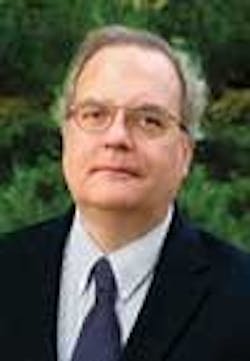Take a bow
America’s Public Broadcasting Service (PBS) encompasses radio and television stations that transmit some of the finest programming in the country. Before tuning in to the Fox News channel to hear biased right-wing reporting (while at the same time having a few laughs), I always check whether my local public station is broadcasting something more important.
One night, I tuned into a concert by Hector Berlioz called the Symphonie Fantastique being broadcast on WGBH in Boston. Conducting the orchestra was a certain Michael Tilson Thomas, an American conductor, pianist, and composer who is currently musical director of the San Francisco Symphony.
Knowing little about music, I wondered how his seemingly manic waving of the baton could have possibly kept the orchestra in time or, in fact, sane! I decided to consult an expert. Luckily I know a lot of them; one such expert is my brother-in-law William Goodchild, an internationally acclaimed composer, orchestrator, and conductor. He’s so talented, in fact, he has conducted the BBC Concert Orchestra and recorded with John Williams.
My question to him was simple. Surely, I said, if an orchestra has practiced well enough, they would not need a conductor. After spending over an hour on the telephone, I realized that the question was more complex than it originally appeared. Although the music may be written down, he said, the interpretation of the music is not an exact science. What person, for example, has listened to a recording of Herbert von Karajan conducting the Berlin Philharmonic Orchestra playing Beethoven’s Symphony Number 3 and not felt that this is a definitive work? Or is it?
According to my brother-in-law, complex pieces such as this can be interpreted in a number of ways because early composers did not exactly specify how individual notes, phrases, or passages should be played. To overcome this, latter-day composers such as Béla Bartók decided to record their own music, showing later musicians how they wanted them to interpret it. Arnold Schoenberg, for example, was so attentive to detail he even transcribed his music so that others would understand how nearly every note should be played.
Despite such efforts, it is still the conductor who remains in command of the final interpretation of an orchestra’s music. For this reason, he or she is often lauded with applause and flowers at the end of every concert.
Encore, encore
Like an orchestra playing a perfectly transcribed piece of music, you may reason that to produce a perfect product you do not need any type of machine-vision system to oversee the manufacturing process. As in Schoenberg’s music, the definition of a product, its color, and its dimensions and specifications can now be described perfectly using CAD-based software tools. By using these tools and stringently controlling the manufacturing process and final assembly, finished products should logically need very little inspection.
Although machine-vision inspection may not be involved in the manufacturing process, many manufacturers sample batches of their products, using human operators to interpret the quality of the finished product. From this information, it may be possible to tweak the manufacturing process to further reduce the number of parts that must be rejected. For some products, this is all that may be required to ensure the satisfaction of the end user.
These production processes may require that the system be dynamically monitored to ensure that relatively consistent products are manufactured. Like the conductor who keeps the beat and interpretation of the music consistent throughout a symphony, machine-vision systems can play a similar role.
Even finely tuned production processes will never be perfect. However, feedback from machine-vision systems enables manufacturers to ensure that the production process is even more closely monitored and, using the data generated, to further reduce the number of rejected parts. While no one would present machine-vision systems with flowers for this accomplishment, they may deserve some applause.
by Andy Wilson, editor
[email protected]

